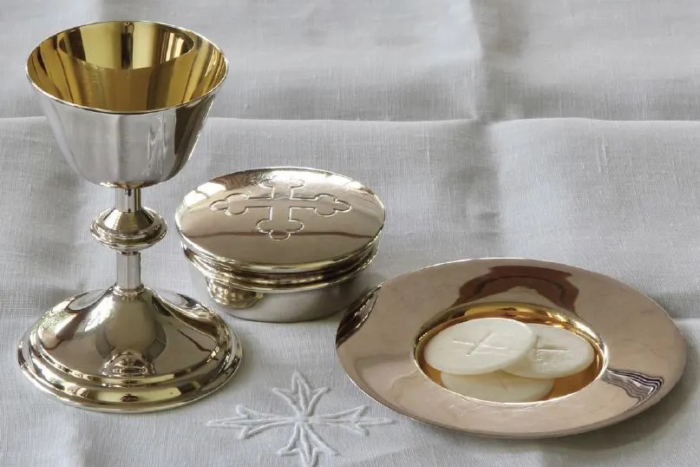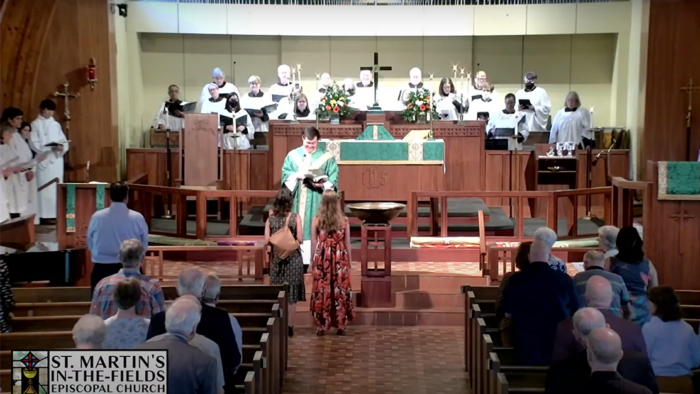Church pairs Eucharist for homebound members with livestreamed services, fostering connectionPosted Feb 3, 2023 |
|
[Episcopal News Service] Grace Allen of Columbia, South Carolina, attended her first service at St. Martin’s-in-the-Fields Episcopal Church in 1959. Last September, at age 91, Allen attended one of her final worship services in the comfort of her own bedroom, with her daughter and granddaughter by her side and a family friend, Sally Peek, on hand to administer Communion.
The bread and wine brought by Peek had been consecrated at the 8 a.m. Sunday service, and in a unique twist on St. Martin’s-in-the-Fields’ traditional Eucharistic visitor ministry, the sacrament was incorporated into Allen’s viewing on YouTube livestream of the congregation’s 10:30 a.m. service. When it was time for worshippers in the church to approach the altar and receive the bread and wine, Allen also took Communion.
“I think what was so special about this format was just being able to share most of the entire service with Grace and her family. I can’t tell you how much richer it makes that experience feel,” Peek, 46, told Episcopal News Service. “I think it’s humbling to be able to share that experience with another person.”

Lay Eucharistic visitors fulfill a common Episcopal ministry, taking Communion kits to homebound church members.
Like many Episcopal churches, St. Martin’s-in-the-Fields has long trained lay Eucharistic visitors to bring the sacrament to homebound members after Sunday worship services have concluded. Those volunteers usually administer Communion by following a condensed worship form written specially for those visits. In the past year, however, the church has experimented with this new variation, in which Eucharistic visitors join in watching the livestream worship, so Communion at home and at church can be simultaneous.
“That’s added a sense of connection, and people are feeling they are participating in the worship service as it’s happening,” the Rev. Mitch Smith, St. Martin’s rector, told ENS.
This is not a virtual Eucharist. That concept sparked some controversy early in the pandemic for its assertion that the bread and wine could be consecrated remotely, such as through Zoom. A June 2020 discussion by the House of Bishops suggested there were strong feelings among the bishops against endorsing the concept of virtual Eucharist.
The only thing virtual about Eucharistic visitation at St. Martin’s-in-the-Fields is the congregation’s livestream. The bread and wine are consecrated in person at the early service and given at the beginning of the second service to the lay Eucharistic visitors, who leave straight for the homes or hospital rooms of the members they are visiting. Some of the volunteers bring along internet-connected tablets, to livestream the service during their visits if the person doesn’t already have that capability.
The new twist on St. Martin’s-in-the-Fields’ Eucharistic visitation is being implemented and overseen by the Rev. Dianna Deaderick, a deacon who began serving the parish a year ago. She previously served for about 12 years at St. Luke’s Episcopal Church, also in Columbia, where one of her roles was training Eucharistic visitors. “It’s not a social call, but it is an extension of the worship service,” Deaderick said in an interview with ENS.
The Eucharistic visitation ministry has deeper meaning than a mere maintenance of homebound members’ sacramental routines, Deaderick said. “I see being a Eucharistic visitor as a way to help people fully live into their covenant.”
She noted that the Book of Common Prayer’s Baptismal Covenant, on page 304, states that believers will “continue in the apostles’ teaching and fellowship, in the breaking of the bread, and in the prayers.”

At a recent livestreamed Sunday service at St. Martin’s-in-the-Fields Episcopal Church in Columbia, South Carolina, the Rev. Mitch King presents consecrated bread and wine to lay Eucharistic visitors to bring to homebound members. Photo: St. Martin’s-in-the-Fields Episcopal Church
For Peek, who brought her 16-year-old daughter, Sophie, with her to visit Allen, it was their first time serving as lay Eucharistic visitors, a fact that they made clear to Allen in case they let any detail slip. “Of course, because we know her, she was really sweet,” Peek said.
A big-screen TV had been set up in Allen’s bedroom, so she could watch the church’s livestream. Allen’s granddaughter sat with her on the bed, while Peek and her daughter sat with Allen’s daughter in chairs next to the bed.
“We sat there and watched the entire service together, which was incredibly special,” Peek said.
During the Liturgy of the Eucharist, Peek brought out a box containing the wafers and a little vial of wine. She set them out on a tray on Allen’s bed, and as the rest of the congregation received Communion, she and her daughter offered “the body of Christ” and “the blood of Christ” to those present, repeating the words that the Eucharistic ministers were saying at the altar.
“She happened to be really special in my life,” Peek said. “I’ve known her granddaughter since I was about 4 years old.” Peek and her daughter volunteered knowing it might be the last time they would be able visit Allen, who was receiving hospice care. Allen died a few weeks later, on Nov. 3.
Priests have the primary role of celebrating Eucharist with homebound members whenever possible. At other times, those church members may receive from the reserved sacrament administered by lay volunteers. The Eucharistic visitors generally follow the form specified in the prayer book under Communion Under Special Circumstances, starting on page 396.
The form “is intended for use with those who for reasonable cause cannot be present at a public celebration of the Eucharist,” according to the prayer book’s rubrics. “It is desirable that fellow parishioners, relatives and friends be present, when possible, to communicate with them.”
When Eucharistic visitors coordinate their visits to coincide with the livestream, that liturgy takes the place of the form in the prayer book for Communion Under Special Circumstances.
St. Martin’s-in-the-Fields spent about $40,000 to install cameras, microphones and a control center that would offer its congregation a professional livestream after the COVID-19 hit in March 2020. Since then, the congregation has fully resumed in-person worship, though it still regularly livestreams Sunday services, funerals and weddings. “It’s absolutely valuable, particularly when we have folks who are homebound, shut-in, sick,” Smith said.
Parish leaders posed the question of how they could further harness the benefits of the new technology. Working with Deaderick, they came up with the idea of enhancing the Eucharistic visitor ministry. For the homebound member watching the livestream, the Eucharistic visitor “becomes a partner in that worship,” Deaderick said.
During the livestreamed service, Smith also acknowledges the homebound member by name in his announcements before Communion, inviting the congregation to offer a collective greeting to that person through the livestream. “It’s a way for us to pass the peace with her, even though she is not physically present,” Deaderick said. “It’s been very, very well received by those of our folks who are participating in this way.”
The congregation has about 10 parishioners trained as Eucharistic visitors, and it averages at least one Eucharistic visit each Sunday. About half of those volunteers choose to carry out the ministry the traditional way, without coordinating their visits with the livestream. A new training is scheduled this month, and all of those trainees will be prepared for pairing their Eucharistic visits with the second Sunday service livestream.
Deaderick also travels on weekdays to administer the sacrament to parishioners who are unable to leave their homes or care facilities. “It’s so meaningful for the folks who receive who are not able to be part of the corporal worship,” she said. “And it creates a bond between me and the parishioners that I would not normally have. … Church is community, and it just strengthens that community.”
– David Paulsen is an editor and reporter for Episcopal News Service. He can be reached at dpaulsen@episcopalchurch.org.

Social Menu